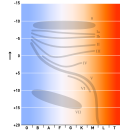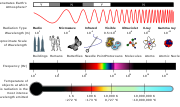A corona (pl.: coronas or coronae) is the outermost layer of a star's atmosphere. It is a hot but relatively dim region of plasma populated by intermittent...
62 KB (7,677 words) - 17:36, 18 October 2024
Look up corona or Corona in Wiktionary, the free dictionary. Corona (from the Latin for 'crown') most commonly refers to: Stellar corona, the outer atmosphere...
6 KB (784 words) - 11:46, 10 November 2024
and titanium oxide. The outermost part of the stellar atmosphere, or upper stellar atmosphere, is the corona, a tenuous plasma which has a temperature above...
7 KB (818 words) - 16:16, 5 January 2024
Star formation (redirect from Stellar nursery)
Observatory. For low-mass stars X-rays are generated by the heating of the stellar corona through magnetic reconnection, while for high-mass O and early B-type...
48 KB (5,543 words) - 03:22, 13 October 2024
Coronavirus (redirect from Corona virus)
image reminiscent of the stellar corona, from which their name derives. The name "coronavirus" is derived from Latin corona, meaning "crown" or "wreath"...
96 KB (10,558 words) - 14:18, 18 November 2024
These high-energy stellar winds blow stellar wind bubbles. G-type stars like the Sun have a wind driven by their hot, magnetized corona. The Sun's wind...
5 KB (591 words) - 21:02, 18 November 2024
1944, Walter Baade categorized groups of stars within the Milky Way into stellar populations. In the abstract of the article by Baade, he recognizes that...
35 KB (3,549 words) - 18:58, 9 November 2024
and corona. The term usually refers to the Sun's chromosphere, but not exclusively, since it also refers to the corresponding layer of a stellar atmosphere...
12 KB (1,355 words) - 20:37, 13 November 2024
Compact object (redirect from Stellar Remnant)
often the endpoints of stellar evolution and, in this respect, are also called stellar remnants. The state and type of a stellar remnant depends primarily...
20 KB (2,582 words) - 02:09, 21 June 2024
Star system (redirect from Stellar system)
A star system or stellar system is a small number of stars that orbit each other, bound by gravitational attraction. A large group of stars bound by gravitation...
41 KB (4,555 words) - 00:43, 11 October 2024
completely obscures the bright light of the Sun, allowing the much fainter solar corona to be visible. During an eclipse, totality occurs only along a narrow track...
83 KB (9,739 words) - 09:32, 4 November 2024
Star (redirect from Stellar radius)
Light from a Hot Stellar Corona Detected with the VLT" (Press release). ESO. 1 August 2001. Retrieved 10 July 2006. "What Is the Sun's Corona? | NASA Space...
148 KB (16,434 words) - 21:24, 25 November 2024
Coronavirus diseases (redirect from Corona virus disease)
shape resembling a stellar corona, such as that of the Sun visible during a total solar eclipse; corona is derived from Latin corōna 'garland, wreath,...
23 KB (1,957 words) - 22:03, 15 November 2024
In astronomy, stars have a variety of different stellar designations and names, including catalogue designations, current and historical proper names...
18 KB (2,165 words) - 06:10, 18 November 2024
telescopes is the basis for many fields of astronomy, including photometry and stellar spectroscopy. Hipparchus did not have a telescope or any instrument that...
14 KB (1,695 words) - 03:06, 17 July 2024
In astronomy, stellar classification is the classification of stars based on their spectral characteristics. Electromagnetic radiation from the star is...
106 KB (11,557 words) - 22:43, 9 November 2024
Bayer, Flamsteed, HR, or Draper (not from the supplements) designation. Stellar extremes or otherwise noteworthy stars. Notable variable stars (prototypes...
7 KB (415 words) - 21:15, 17 April 2023
In astrophysics, stellar nucleosynthesis is the creation of chemical elements by nuclear fusion reactions within stars. Stellar nucleosynthesis has occurred...
37 KB (4,238 words) - 21:20, 1 October 2024
dwarfs, and white dwarfs which are much more common, the latter being stellar remnants). A G-type main-sequence star with the mass of the Sun will fuse...
12 KB (1,170 words) - 15:02, 23 November 2024
Substellar object (redirect from Sub-stellar objects)
enough mass to fuse hydrogen and helium, hence do not undergo the usual stellar evolution that limits the lifetime of stars. A substellar object with a...
7 KB (881 words) - 09:41, 21 September 2024
corona and lack a convection zone in their outer atmosphere. They have a higher mass loss rate than smaller stars such as the Sun, and their stellar wind...
12 KB (1,369 words) - 11:26, 21 July 2024
In astronomy, stellar kinematics is the observational study or measurement of the kinematics or motions of stars through space. Stellar kinematics encompasses...
60 KB (7,016 words) - 21:20, 1 October 2024
Radiative zone (redirect from Eddington stellar model)
Introduction to Stellar Astrophysics (1st ed.). John Wiley and Sons. p. 168. ISBN 978-1-119-96497-1. Pols, Onno Rudolf (2011). Stellar Structure and Evolution...
11 KB (1,732 words) - 00:52, 27 October 2024
Apparent magnitude (redirect from Stellar magnitude)
1×1014 kilometres; 1.9×1014 miles). Therefore, it is of greater use in stellar astrophysics since it refers to a property of a star regardless of how...
66 KB (4,802 words) - 14:02, 20 November 2024
Neutron star (redirect from Stellar spin-down)
holes, neutron stars are the second smallest and densest known class of stellar objects. Neutron stars have a radius on the order of 10 kilometers (6 mi)...
115 KB (13,830 words) - 21:58, 16 November 2024
magnetic field lines that stretch out into the stellar corona. These in turn serve to heat the corona to temperatures over a million kelvins. The magnetic...
22 KB (2,725 words) - 21:20, 1 October 2024
X-rays, enabling studies of these phenomena. X-rays are also emitted by stellar corona and are strongly emitted by some types of nebulae. However, X-ray telescopes...
48 KB (4,877 words) - 22:28, 12 November 2024
Stellar parallax is the apparent shift of position (parallax) of any nearby star (or other object) against the background of distant stars. By extension...
22 KB (2,778 words) - 12:33, 13 October 2024
Stellar evolution is the process by which a star changes over the course of its lifetime and how it can lead to the creation of a new star. Depending...
50 KB (6,476 words) - 03:27, 27 October 2024
Metallicity (redirect from Stellar metallicity)
helium are termed metallic. The presence of heavier elements results from stellar nucleosynthesis, where the majority of elements heavier than hydrogen and...
41 KB (4,777 words) - 21:26, 7 November 2024

























